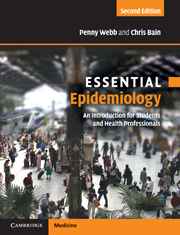Book contents
- Frontmatter
- Contents
- Foreword
- Preface
- 1 Epidemiology is…
- 2 How long is a piece of string? Measuring disease frequency
- 3 Who, what, where and when? Descriptive epidemiology
- 4 Healthy research: study designs for public health
- 5 Why? Linking exposure and disease
- 6 Heads or tails: the role of chance
- 7 All that glitters is not gold: the problem of error
- 8 Muddied waters: the challenge of confounding
- 9 Reading between the lines: reading and writing epidemiological papers
- 10 Who sank the boat? Association and causation
- 11 Assembling the building blocks: reviews and their uses
- 12 Outbreaks, epidemics and clusters
- 13 Watching not waiting: surveillance and epidemiological intelligence
- 14 Prevention: better than cure?
- 15 Early detection: what benefits at what cost?
- 16 A final word…
- Answers to questions
- Appendix 1 Direct standardisation
- Appendix 2 Standard populations
- Appendix 3 Calculating cumulative incidence and lifetime risk from routine data
- Appendix 4 Indirect standardisation
- Appendix 5 Calculating life expectancy from a life table
- Appendix 6 The Mantel-Haenszel method for calculating pooled odds ratios
- Appendix 7 Formulae for calculating confidence intervals for common epidemiological measures
- Glossary
- Index
- References
3 - Who, what, where and when? Descriptive epidemiology
- Frontmatter
- Contents
- Foreword
- Preface
- 1 Epidemiology is…
- 2 How long is a piece of string? Measuring disease frequency
- 3 Who, what, where and when? Descriptive epidemiology
- 4 Healthy research: study designs for public health
- 5 Why? Linking exposure and disease
- 6 Heads or tails: the role of chance
- 7 All that glitters is not gold: the problem of error
- 8 Muddied waters: the challenge of confounding
- 9 Reading between the lines: reading and writing epidemiological papers
- 10 Who sank the boat? Association and causation
- 11 Assembling the building blocks: reviews and their uses
- 12 Outbreaks, epidemics and clusters
- 13 Watching not waiting: surveillance and epidemiological intelligence
- 14 Prevention: better than cure?
- 15 Early detection: what benefits at what cost?
- 16 A final word…
- Answers to questions
- Appendix 1 Direct standardisation
- Appendix 2 Standard populations
- Appendix 3 Calculating cumulative incidence and lifetime risk from routine data
- Appendix 4 Indirect standardisation
- Appendix 5 Calculating life expectancy from a life table
- Appendix 6 The Mantel-Haenszel method for calculating pooled odds ratios
- Appendix 7 Formulae for calculating confidence intervals for common epidemiological measures
- Glossary
- Index
- References
Summary
The rates and measures you have been exploring in Chapter 2 provide a variety of ways of describing the health of populations and thus also enable us to compare patterns of health and disease between populations and over time. This allows us to answer the core questions relating to disease burden that are the essential first step in setting health planning and service priorities. As we discussed in Chapter 1, this descriptive epidemiology, concerned as it is with ‘person, place and time’, attempts to answer the questions ‘Who?’, ‘What?’, ‘Where?’ and ‘When?’. This can include anything from a description of disease in a single person (a case report) to the national health surveys conducted in many countries. Most reports of routine population data, including variations in rates of disease in different geographical areas and changing rates of disease over time (time trends), also come under the heading of descriptive epidemiology. But while descriptive studies or reports are essential to identify health problems and may lead to suggestions as to why something has occurred, they cannot usually answer the question ‘why?’. Descriptive epidemiology may, however, provide the first ideas about causality and thus generate hypotheses that can then be tested in more formal ‘analytic’ studies that we will discuss in Chapter 4. As you will come to see, descriptive studies can also play a critical and often under-appreciated role in monitoring the effects of large-scale interventions.
- Type
- Chapter
- Information
- Essential EpidemiologyAn Introduction for Students and Health Professionals, pp. 71 - 93Publisher: Cambridge University PressPrint publication year: 2010

